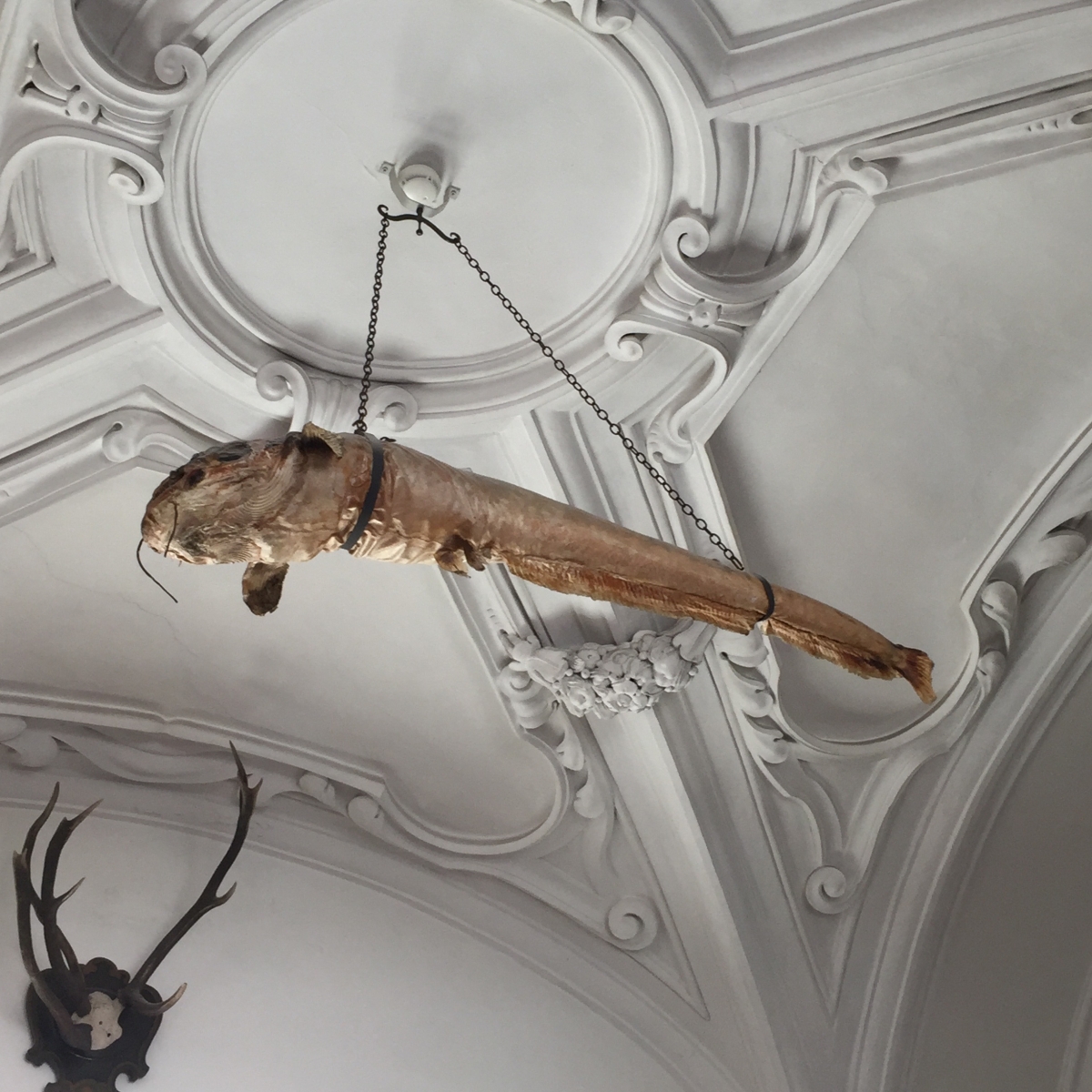 Anna-Sophie Berger (b. 1989) lives and works between Vienna and New York. I first came across her work in 2016, in her solo show “Places to Fight and to Make Up” at MUMOK, Vienna. I was instantly impressed by her artistic ability to charge works with stories crafted in a light but especially personal manner, to freely manipulate existing signifiers and create new ones. I remember thinking that the multilayered fabric of artistic language woven by the artist through a variety of media reflects what it means to operate in the artistic field today, i.e. finding ways to talk about the mundane and at the same time not drown in it, to keep one’s distance while abstracting experiences and objects but also preserve the sense of intimate connection to them. Given all this, the opportunity for conversation, especially while branching off of the theme of “Empathy”, enabled me to ask a few questions which have been scratching at the back of my head for a while now.
Anna-Sophie Berger (b. 1989) lives and works between Vienna and New York. I first came across her work in 2016, in her solo show “Places to Fight and to Make Up” at MUMOK, Vienna. I was instantly impressed by her artistic ability to charge works with stories crafted in a light but especially personal manner, to freely manipulate existing signifiers and create new ones. I remember thinking that the multilayered fabric of artistic language woven by the artist through a variety of media reflects what it means to operate in the artistic field today, i.e. finding ways to talk about the mundane and at the same time not drown in it, to keep one’s distance while abstracting experiences and objects but also preserve the sense of intimate connection to them. Given all this, the opportunity for conversation, especially while branching off of the theme of “Empathy”, enabled me to ask a few questions which have been scratching at the back of my head for a while now.
Audrius Pocius: Dear Anna-Sophie, I am grateful for the opportunity to talk to you in the context of this issue of Artnews.lt. Not only do I feel that you, of all people, might reflect on the term “empathy” with great care, but also because the idea of empathy is something essential to my work as a curator, which has a lot to do with caring (from Latin “curare”). Your work has a lot to do with caring in the latter sense. You have mentioned in another interview at “Flash Art” that for you and in your practice “caring is an act of choice, of decision-making”. [1] However, I feel that empathy is not something you choose, but something you give in to, it does not have the rationale of a choice, but rather grounds it. Following this logic, the most productive gesture in the face of empathy is not a wilful act, but wilful restraint. Do you relate to that in you practice?
Anna-Sophie Berger: Let me see if I understand you correctly: your point being that empathy as a feeling or capacity – rather than willful act of care – happens to the person sensitive enough to feel with and for others. And then, further, to navigate these “feelings of empathy” that catch us whether we choose so or not, restraint would be to productively navigate them. Like holding back on being swallowed by emphatic grief, carrying on despite feeling bad for the world or a person, and ultimately rendering productive the muddled sentiments, e.g. via translating them into works of art. I relate to this, but I maybe never approached it via the term “empathy”. I feel that being an artist who puts their work above everything includes a certain recklessness towards sentiments. To make productive the things we feel strongly, to not be thrown off one’s feet but to actually use what one sees to create things calls for a certain separation. And, at the same time, I thrive off of the things – awful or not – I find in the world and that touch me emotionally. I don’t want to call this masochistic, it’s rather that emotive understanding of one’s surroundings leads to works that can display empathy, or solidarity – which is another interesting word in that context, maybe the historical-political sister.
I recently read about Roland Barthes’s description of text as “historic solidarity”, by which he refers to the style of writing rather than form or content, style being inherently influenced by the author’s entanglement within their own times. This too could be evoked when talking empathy. But to go back to your question – I like the idea of willful restraint too. Anything willful I like, lol. I am a defiant constructivist: I always put the pressure back at the individual, asking of myself to be willful in my actions and to take responsibility for them. Being taken over by external forces is very hard for me. Becoming more adult has been about understanding that there are such things as uncontrollable emotive states. Willful restraint could therefore also relate to “choice”, as banal as that may seem. What we choose to not do, to not yield to, to leave out is just as important as what we ultimately decide to do. It is a binary – and I know the times are not in favor of binaries – but for me this push and pull of resisting and giving in is one of the foundations of my art making. It is not even about whether a choice is universally correct, it’s more about my trying for a thing, choosing it, making that choice and being responsible for it. What Alain Badiou calls “the curbing of chance” in “In Praise of Love”.

Anna-Sophie Berger, Untitled, 2018. Photography, 60 x 42 cm. Courtesy of the artist and JTT Gallery New York
AP: I am curious about the texts that precede or follow your pieces. They are neither explanatory, nor add something to the immediate experience of the works. Rather, they create a certain background where signs and things you care about in certain works become protagonists in a very personal diary-like reflection. In the text called “The Eternal Optimist”, for example, optimism becomes the prospect of unavoidable consumption, thus painful and boresome. And then, also, the metaphorical food chain of which you wrote:
<…>
“what the aim is was my question when
I started here and its universality now
disgusts me
It disgusts me how the same existential-
ism is the same at all times for death and creation.
it disgusts me that I am ambivalent but
cannot embrace complexity instead of
dualism.
the aim is the sword of Damocles, the
knife I just bought is but a cheap symbol
for the threat of the aim.”
<…>
How do the text and the works relate to each other, how do they overlap in time?
ASB: This is a tricky question, for answering it will have me run the risk of turning these attempts into tautologies. I just had a conversation last week with someone arguing about the aspirations of sculptors as expressed in text and the discrepancies that can exist between an object and its description in words. The things it can and cannot say. Or: what do we even want it to say, and if so, had we not better chosen text or narrative figuration? Making sculpture for me is about the semiotic threshold, and the tensions that can build up in an object as a partially ambiguous sign. To keep this crisp, maybe the answer is simple: I am the optimist, a character but also the artist. A person. What I think and fear is relevant to what I make, though it doesn’t have to be understood as prescriptive for an understanding of the things I make. Since I perceive making art as part of my existence, it would be nonsensical for me to sever that bond, let alone disguise it. This piece of writing is just as much fiction as it is real pain as it is simply – going back to being reckless and making useful the world of emotions – a preamble to making strange things.

Anna-Sophie Berger, preposition, 2016. Courtesy of the artist and JTT Gallery New York
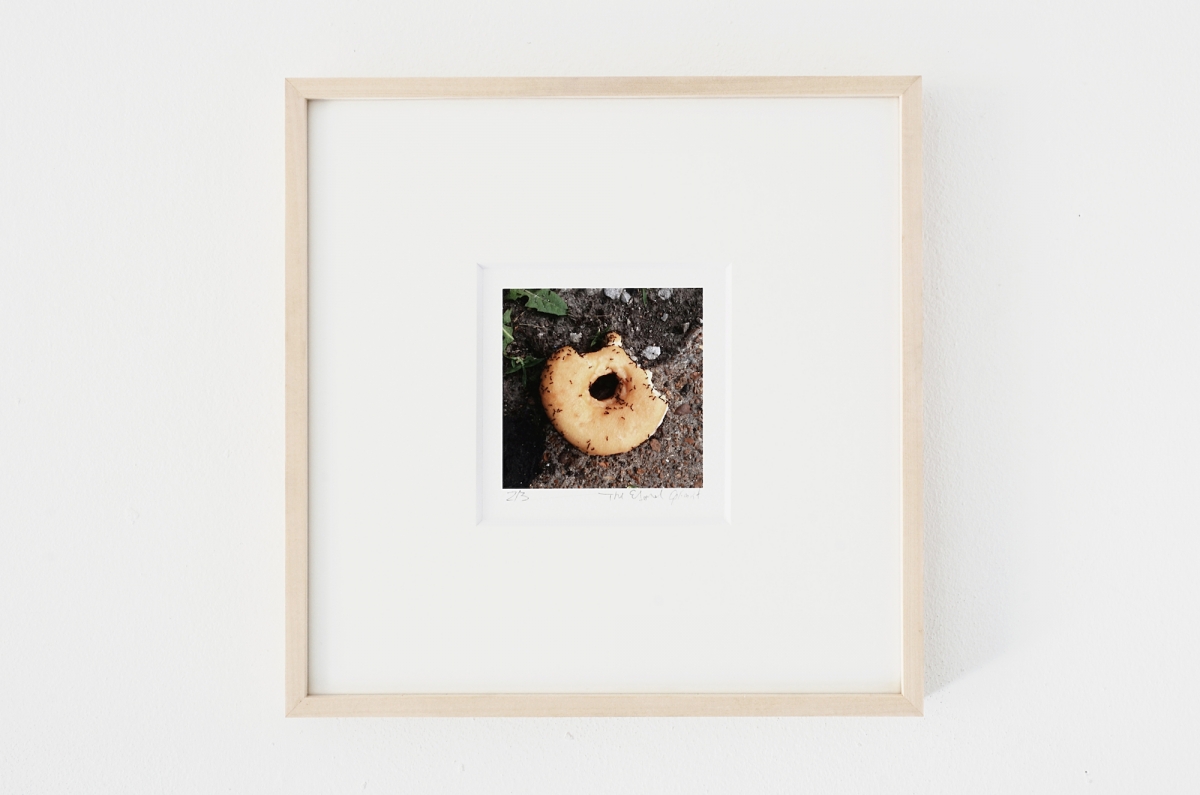
Anna-Sophie Berger, The Eternal Optimist, 2016. Courtesy of the artist and JTT Gallery New York. Photo: Jonas von Ostrowski
AP: Given what you said, I started imagining this process as one of gathering and letting go. For me, at least, language manifests as a form of ownership, once you give something a name, you immediately acquire it and utilise it in your system of signs, a.k.a. reality. However, as you said, your art lurks on the semiotic threshold, which is a place that neither you as an artist nor the viewer can be totally in control of. In a way, I find it an interesting dynamic, one reenacting some of the old problems of authorship discussed by Barthes and Bakhtin, as well as the Chicago literary school. It is best illustrated by the analogy of seeing and listening to the “protagonist” of the artwork. The only way for the artwork to remain free of the authoritarian gaze of the author is if the author is sensible enough to be temporary-present or contemporary with its creation. It is, I think, an interesting form of empathy that, in case of your work, has a lot to do with what can be uttered and what should be kept silent.
ASB: The death of the author is a funny problem for me. I think in my generation, a past-postmodernism of sorts, there is a general mistrust in all prescriptive readings of an art. Or maybe I should say I feel that way. All systematic attempts to read art seem strangely impossible compared to the way the individual can make art in 2017. Obviously, reducing work to individual genius is untenable, an opposition to biography and intention of the artist/author seems logical, but the concept to me still feels no less outdated as, let’s say, the concept of aura. When Barthes wrote this, it was an argument for the freedom of text / work. It cannot be read that way anymore, since it now canonizes a well implemented critical theory that aims to define how art should work. What I do relate to is the wish to “not put a limit to a text”. Biography and individual artistic intention cannot be and should not be the only reference point. But in a practice that is intensely subjective, often personal and nostalgic, there is no helping this connotation. I don’t care whether the auctorial me and the person at home on the sofa align at all times, but I choose to share those sofa thoughts. Art is an existential practice to me and even if, at best, performed, it can attain a sort of universality that then needs nothing of me to be understood by someone else, I will still attribute value to my messing with things out of subjective reasons. And that perhaps is what guarantees the temporary present you refer to.

Research material, Google
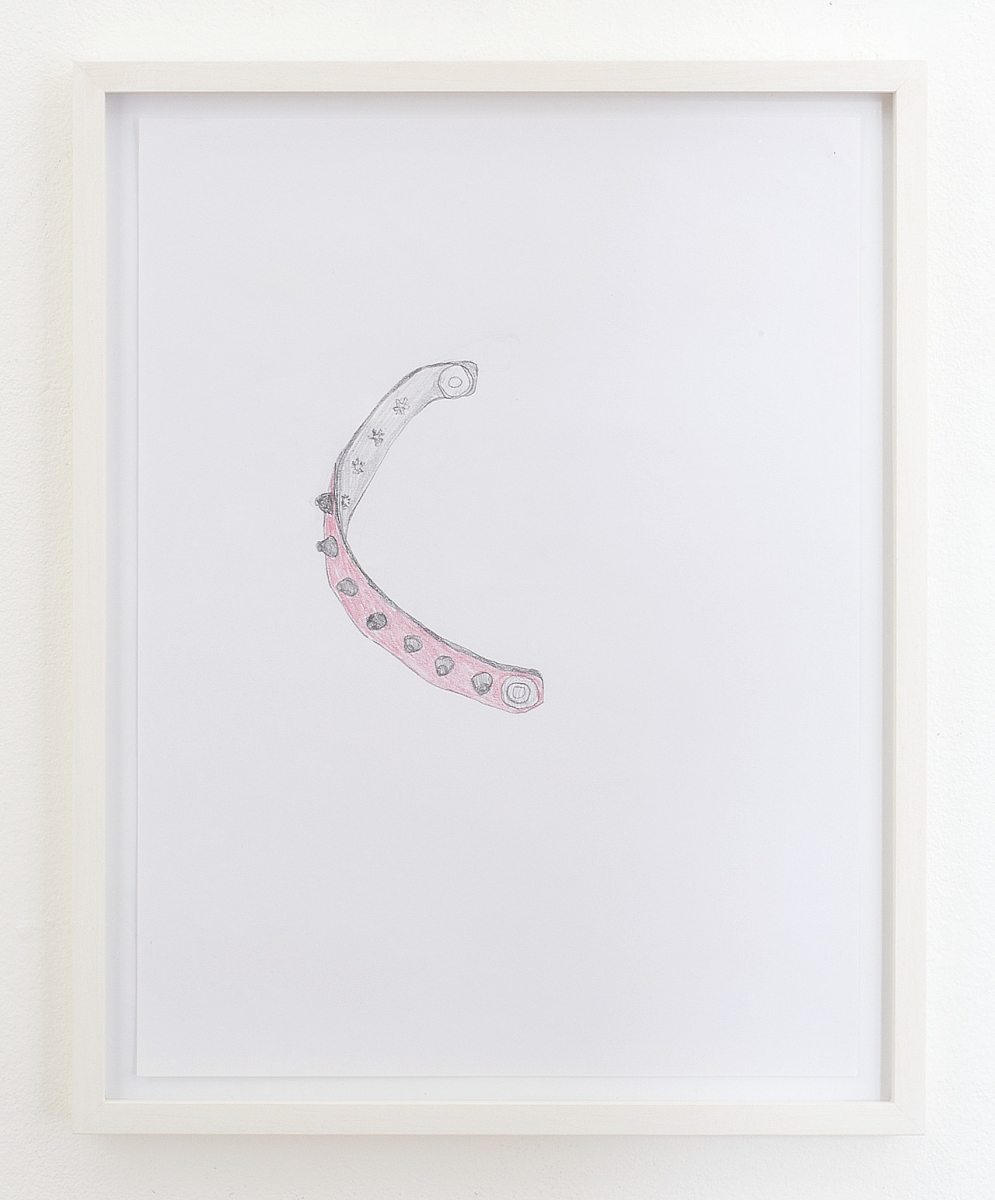
Anna-Sophie Berger, untitled, 2017. Courtesy of the artist
AP: Speaking of binaries in your work, one of the best examples of this binary movement in my imagination is the piece “The Nest Is Served”, that has been shown at Gallerie Emmanuel Layr in Rome, as well as “Keeping Things”, an installation for ARS VIVA at Kunstverein Muenchen. These are glorified, empty cages, displayed as if they were luring the viewer in, seducing him or her and almost giving promises of nurture. In a way, they are great vehicles for narratives, leaving me curious: what kind of gesture was it for you to put them there? They radiate care and at the same time offer a brutal restraint.
ASB: I think, as much as they came out of a similar investigation of collapsing of space and restraining of movement, they are very different to me now. “The Nest Is Served” was essentially about the formal make believe of a very well-known object – a cage – which’s primary feature is to impair or restrain movement. As my object formally takes stylistic and material qualities from a child’s bed or crib, the notion of impairment is softened and an element of cosiness and protection is introduced. Both of these projected attributes – imprisonment and protection – are unfulfilled in the very object, as the cage bars are wide enough to let bodies pass through them easily. This frustration of a desired effect, or the make-believe thereof, is what was on my mind.
With “Keeping Things”, however, the idea was more strictly about frustration. The elimination of play and closure of an open field, as described by two football goals. And all that through an intervention that is small and almost comical in relation to the massive steel objects – two small shackles of same material, almost like bike locks. Others have told me there was a palpable erotic in this piece, which I like too. In a way, now that I think about it, “Keeping Things” looks like the sexy companion to the infantile inhibition of “The Nest Is Served”.

Anna-Sophie Berger, keeping things, 2017, 300 x 200 x 200 cm. Courtesy of the artist, Emanuel Layr Gallery ir JTT Gallery
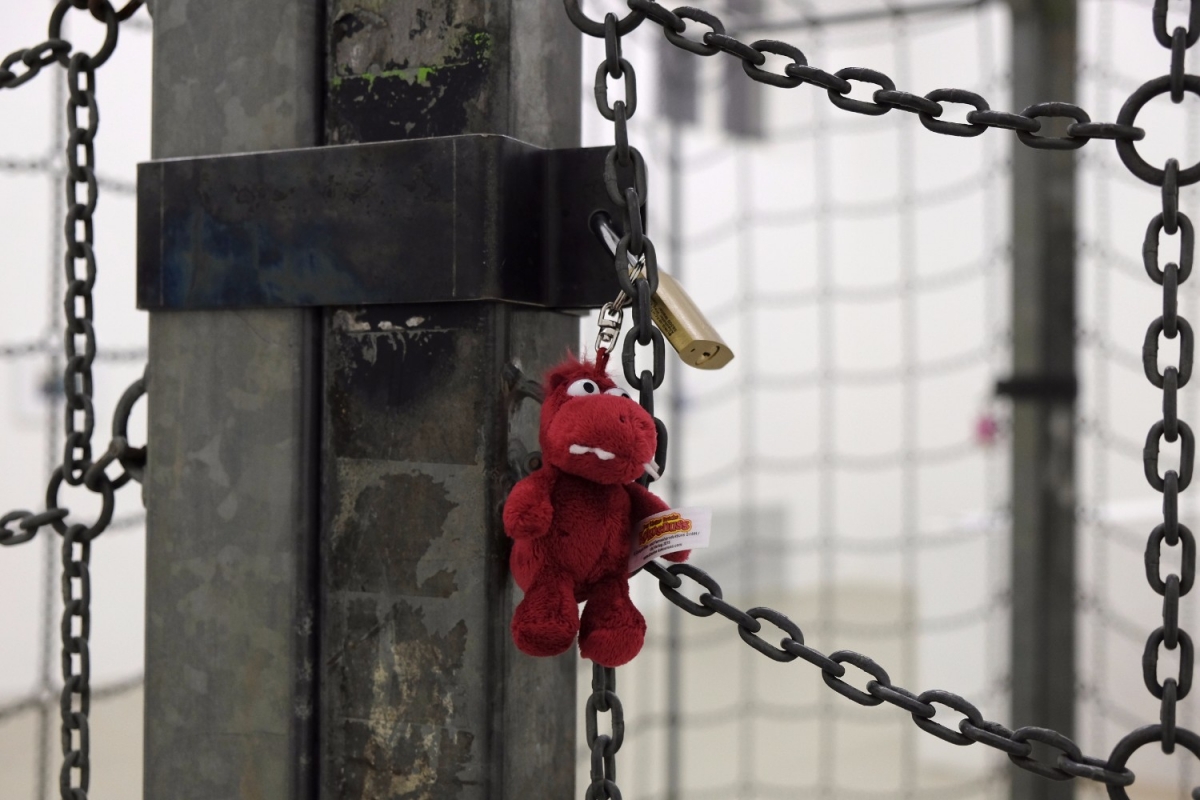
Anna-Sophie Berger, keeping things, 2017, detail. Courtesy of the artist, Emanuel Layr Gallery ir JTT Gallery
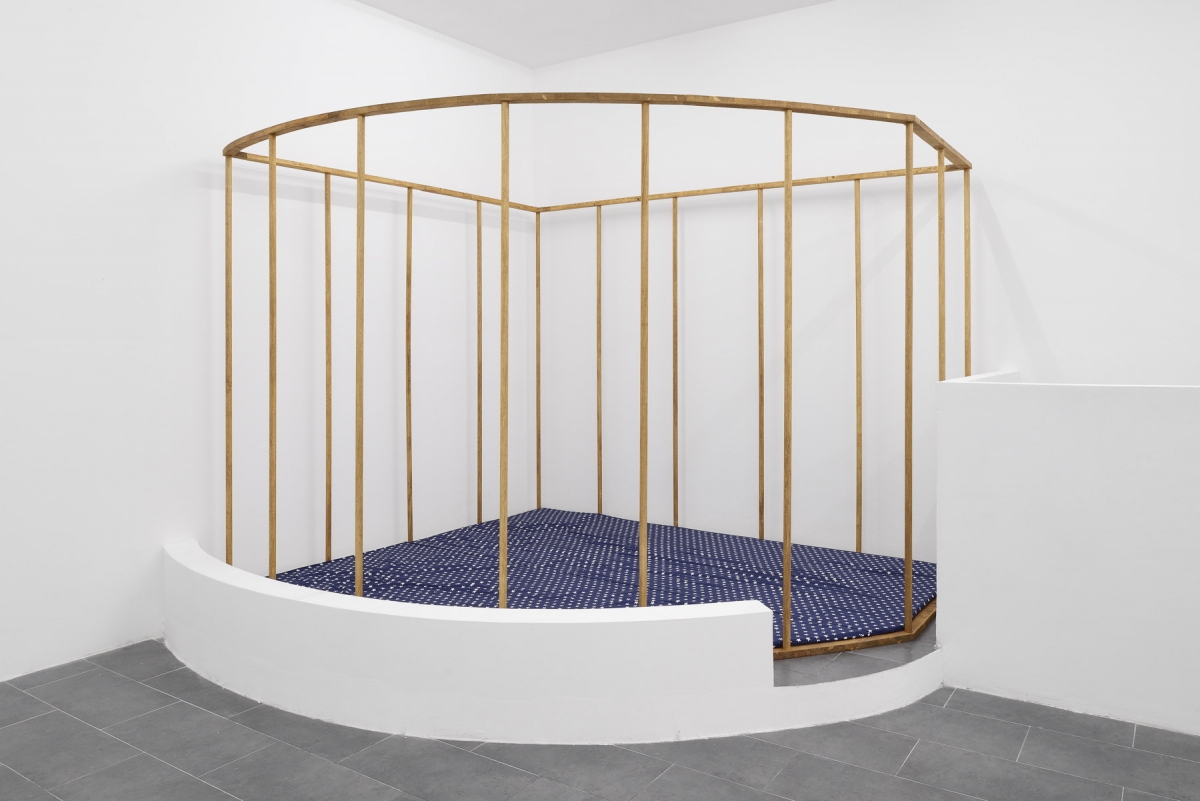
Anna-Sophie Berger, The Nest Is Served, 2017. Courtesy of the artist and Emanuel Layr Gallery. Photo: Roberto Apa
AP: The infantile and the sexy is another interesting binary in your work, manifesting also in the form of the honest and straightforward and the secretive and unattainable. I often think about this tension when I think about your work with garments, like “She Vanished” (2016) or the concrete coat series. To me these pieces are very charged, and it is mainly due to the absence of a body. We are accustomed to view clothing and fashion products on people’s bodies that give shape to them and these pieces obliviate that, collapsing into formless, sluggish things. Although, as utilitarian objects, they indicate a wearer, here they also become the protagonists as if they are the ones that would provide the shape to the user and not vice versa. Also, the motif of locks and chains adds to this impression as, especially when they are transformed into wearables, turning the body into a space rather than an object in the Bachelardian sense.
ASB: Body as a space is interesting in relation to clothing. Especially when we perceive ourselves as mobile. Clothing can then be viewed as the most immediate shell, the tent we carry through the world, but also the most immediate sign of individuation. There is such a delicacy in the intimacy of body touching on fabric, imprinting fibres, staining them with sweat and smell. That too, of course, relates strongly to erotic. I am obsessed with the possibilities and impossibilities to relate to an absent body via this shell, the t-shirt left behind, the discarded or lost pants. There is violence in this absence, too, and a notion of the fragility of body as opposed to cloth. Clothes as relics are uncanny precisely because of this. And yes, there is, of course, a certain figurative independence in an object that mirrors bodily features. Perhaps like in my piece “When I am with you / When I am not there” – in which the line between a subject speaking of these coats that are holding hands or the coats as figures speaking to us are blurred.
One thing that is a constant constructive problem for me in my work, is the question of how to best work and show the body that can inhabit an object. It is almost a banal question, but since I make exhibitions that are often static in their ultimate outcome, like sites, I end up having to solve sculptural questions. How can an object that is best worn and filled up by a body be presented in a different state, with or without auxiliary structures that replicate live body, with or without photography? I recently worked on a photograph, a portrait if you will, that came out of this necessity. The piece featured is made of a crude steel chain and forms a type of slip. It was conceived as a sculpture, yet came out of a bodily feeling somewhere yet again between play and restriction.

Anna-Sophie Berger, she vanished 1, 2015. Courtesy of the artist and JTT Gallery New York
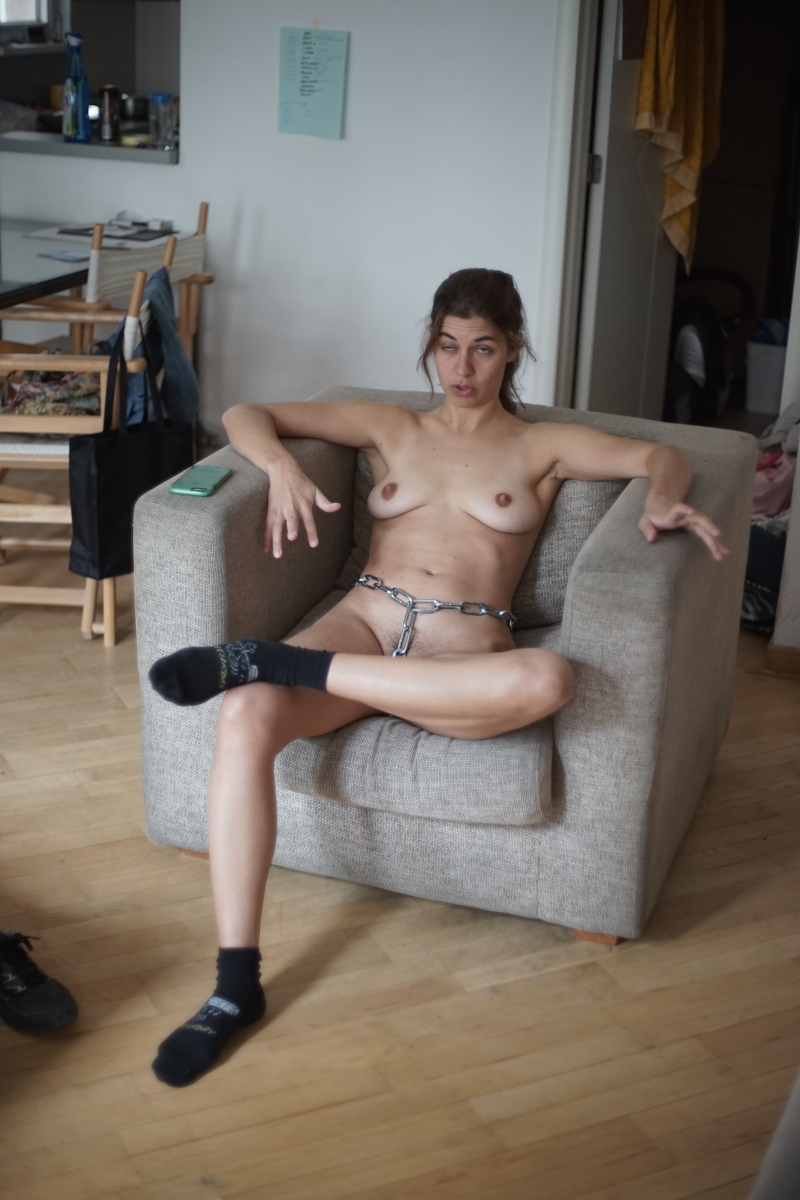
Anna-Sophie Berger, Untitled Portrait, 2017. Photo: Katerina Šoškić
AP: I was also thinking about what you said about solidarity as the historical-political counterpart of empathy. I was thinking about where to find it in your work and had a quick impression that it dwells in a certain submission to the order of things. A choice to participate in the circle of consumption and accept it as a form of communication. Would you agree? Specifically, I find the jester pieces with consumer goods, like “Hunch”, very ironic in this regard.
ASB: “A choice to participate in the circle of consumption” – hm, my position would be more like this: I like objects as I find them in the world that I live in, I think they carry the traces of human interaction and care while we use them and imprint our intention on them. I have said on different occasions that to make conscious decisions about things – hence their respective consumption – we have to acknowledge their value first.
AP: Hmm… You mean like the “Pea Earrings” (2015)?
ASB: Yeah, like that.
And I’m asking you to hold me
Just like the morning paper
Pinched between your pointer
Your index and your thumb
(From: “Harness your Hopes”, Stephen Malkmus, “Pavement” 1999)
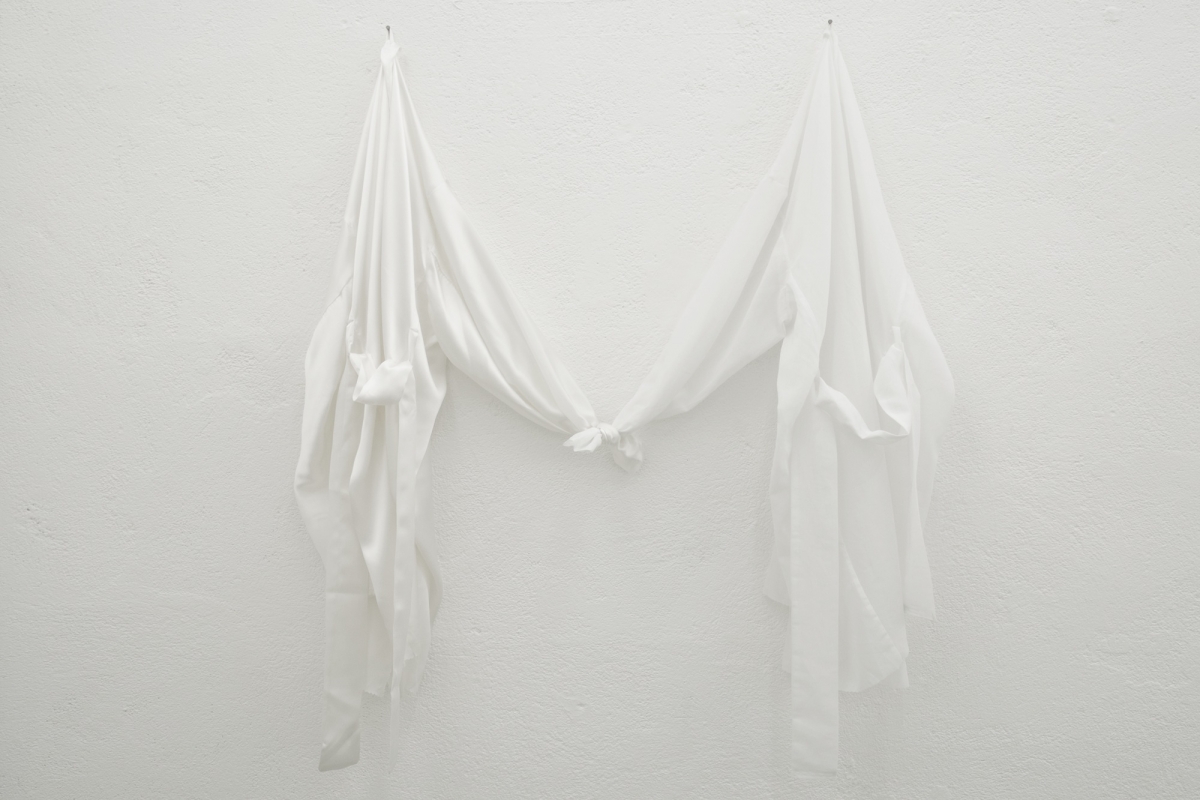
Anna-Sophie Berger, when I am with you / when I am not there, 2015. Courtesy of the artist and JTT Gallery New York
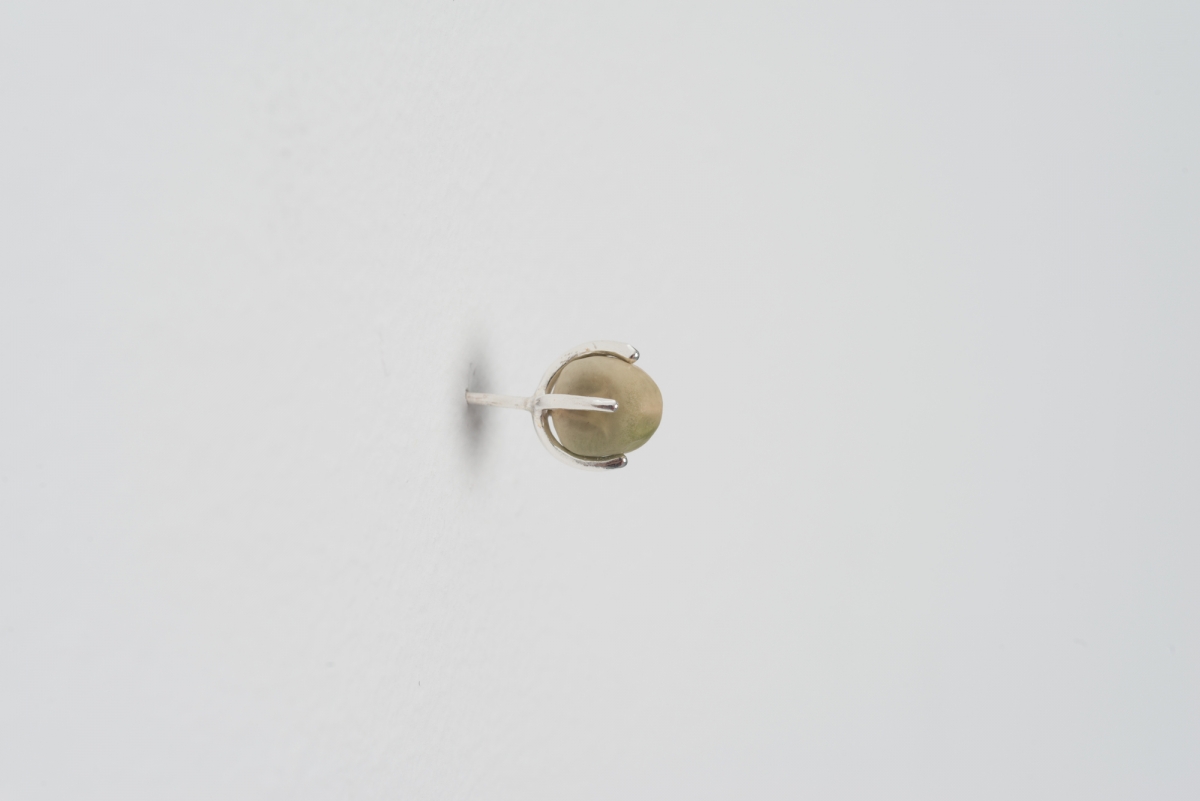
Anna-Sophie Berger, Pea earring, 2015, 1 x 0,5 cm. Courtesy of the artist and JTT Gallery New York. Photo: Klaus Pichler
[1] Flash Art, January / February 2017, p. 43






























